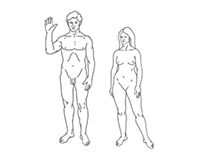The dog days or dog days of summer are the hot, sultry days of summer. They were historically the period following the heliacal rising of the star system Sirius, which Greek and Roman astrology connected with heat, drought, sudden thunderstorms, lethargy, fever, mad dogs, and bad luck. They are now taken to be the hottest, most uncomfortable part of summer in the Northern Hemisphere.
In addition to following Orion into the night sky, the Dog Star Sirius can be easily located in the heavens by following the line created by the prominent asterism (a popularly-known group of stars) Orion’s Belt.
The English name is a calque of the Latin ‘dies caniculares’ (lit. ‘the puppy days’), itself a calque of the Greek ‘kynádes hēmérai’ (‘dog days’). The Greeks knew the star Alpha Canis Majoris by several names, including Sirius (‘Scorcher’), ‘Sothis,’ and the ‘Dog Star.’ The last name reflects the way Sirius follows the constellation Orion into the night sky.
Sirius is by far the brightest proper star in the night sky, which caused ancient astronomers to take note of it around the world. In Egypt, its return to the night sky became known as a precursor to the annual flooding of the Nile and was worshiped as the goddess Sopdet. In Greece, it became known as the precursor of the unpleasantly hot phase of the summer. Greek poets even recorded the belief that the return of the bright star was responsible for bringing heat and fever with it; it was also associated with sudden thunderstorms. In Homer’s ‘Iliad,’ probably composed in the 8th century BCE but representing an earlier tradition, Achilles’ approach towards Troy, where he will slay Hector, is illustrated through an extended metaphor about the baleful effects attending the return of Sirius.
The rising of Sirius during this period has been calculated as 19 July (Julian). Writing about the same time, Greek poet Hesiod, however, considered the worst and hottest part of the summer to be the days before Sirius returned to the night sky. During this period, Sirius was invisible from the earth but it was apparently understood to still be in the sky, augmenting the power of the sun.
This effect of the combination of Sirius’ light with the Sun’s was understood to have an effect on plants, animals, and women, as well as men: ‘But when the artichoke flowers, [i.e., June] and the chirping grass-hopper sits in a tree and pours down his shrill song continually from under his wings in the season of wearisome heat, then goats are plumpest and wine sweetest; women are most wanton, but men are feeblest, because Sirius parches head and knees and the skin is dry through heat.’
About a century later, Greek lyric poet Alcaeus repeated the theme, advising his listeners to ‘steep your lungs in wine’ before the arrival of the star since ‘women are at their foulest but men are weak since they are parched in head and knees.’ In the 3rd century, Greek didactic poet Aratus’ ‘Phenomena’ describes the time as Sirius blighting the bark of trees with its heat during the time it rises and sets with the sun.
The Kean priests of Zeus as Rainmaker and Lord of Moisture observed annual sacrifices before the rise of Sirius to prevent scorching drought. This practice was credited to the culture hero Aristaeus. Aristotle mentions the proverbial heat of the dog days as part of his argument against an early formulation of evolution in his ‘Physics.’
The Romans continued to blame Sirius for the heat of the season and attendant lethargy and diseases. In his ‘Georgics,’ Roman poet Virgil notes vintners’ efforts to protect their work during the time ‘when the Dog-star cleaves the thirsty Ground.’ Roman Stoic philosopher Seneca’s ‘Oedipus’ complains of ‘the scorching dog-star’s fires.’ Roman naturalist Pliny’s ‘Natural History’ notes an increase in attacks by dogs during July and August, and advises feeding them chicken manure to curb the tendency. In the early 20th century, historians still noted the ‘discouraging heat’ and ‘oppression’ of the dog days of the Roman summer.
The period has long featured in western medicine. The 1564 ‘English Hope of Health’ counseled that purging (bloodletting and induced vomiting) should be avoided during the ‘Dogge daies’ of summer because ‘the Sunne is in Leo’ and ‘then is nature burnt vp & made weake.’ The 1729 ‘British Husbandman’s Practice’ claimed that ‘The Heat of the Sun is so violent that Men’s bodies at Midnight sweat as at Midday: and if they be hurt, they be more sick than at any other time, yea very near Dead.’ It therefore advised men to ‘abstain all this time from women’ and to ‘take heed of feeding violently.’ In the 1813 ‘Clavis Calendria,’ the dog days are a time wherein ‘the Sea boiled, the Wine turned sour, Dogs grew mad, Quinto raged with anger, and all other creatures became languid; causing to man, among other diseases, burning fevers, hysterics, and phrensies.’
Even after astrology and its influence on health and agriculture waned in importance, the ‘dog days’ continues to be vaguely applied to the hottest days of the summer, with its attendant effects on nature and society. In North America, it became proverbial among farmers that a dry growing season through the dog days was preferable to the trouble of a wet one.
The Daily Omnivore
Everything is Interesting



Leave a comment